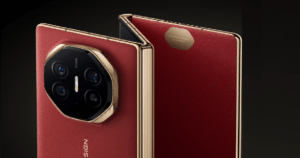Huawei Unveils World’s First Tri-Foldable Phone, Defying US Tech Curbs – But Can It Succeed?
Huawei has launched the Mate XT, the world’s first tri-foldable phone, showcasing its innovation despite ongoing US tech restrictions. Priced at $3,662, it features a 10.2-inch screen and is the thinnest foldable phone at 3.6mm. However, challenges like high pricing, limited app support, and lack of Google services could hinder its global success.

Huawei Unveils World’s First Tri-Foldable Phone, Defying US Tech Curbs – But Can It Succeed?
Huawei has recently launched its innovative Mate XT, a tri-foldable smartphone that marks a significant milestone for the company in the global tech landscape. The device, first unveiled in China five months ago, was officially introduced at a global event in Kuala Lumpur on February 18, 2025. The launch comes as a symbolic triumph for the Chinese tech giant amidst the ongoing technology curbs imposed by the United States. These restrictions have limited Huawei’s access to crucial components, including advanced chips, and denied its devices access to Google services, such as the Play Store and other key software.
Despite these challenges, Huawei’s Mate XT has drawn attention for its unique design and specifications. Unlike traditional foldable phones that typically have two panels, the Mate XT is called a “trifold,” featuring three mini-panels, and it folds twice to create a compact device. At just 3.6 mm (0.14 inches) thick, it is currently the thinnest foldable phone on the market. The phone boasts a large 10.2-inch screen, which is comparable to the display size of an Apple iPad, offering users an expansive viewing experience in a compact form. With a price tag of €3,499 ($3,662), the Mate XT positions itself as a high-end device, appealing primarily to tech enthusiasts and early adopters rather than the average consumer.
Despite the excitement surrounding the launch, experts caution that the Mate XT may face several hurdles that could hinder its broader success. Bryan Ma, Vice President of Device Research at the market intelligence firm IDC, highlighted that while Huawei’s trifold design is unique, the phone’s high price could limit its mainstream appeal. He also acknowledged that Huawei’s success in this segment is noteworthy, given that the company has been forced to innovate without access to crucial US-based technologies and services, such as Google’s Android operating system and the Play Store. Nevertheless, Ma emphasized that Huawei’s resurgence over the past year has been a significant achievement, especially considering the roadblocks imposed by US trade policies.
Huawei’s ability to dominate the foldable phone market in China has been impressive, capturing a 49% market share in the region last year. On the global stage, however, Huawei trails behind Samsung, which holds a 33% market share in 2024. Despite this, Huawei’s global share of the foldable phone market remains strong, with a 23% share as of last year. According to IDC, the foldable phone market is poised for significant growth, with global shipments expected to rise from over 20 million units in 2024 to 45.7 million units by 2028.
While Huawei’s foldable phone demonstrates its technological prowess, analysts like Ruby Lu from TrendForce note that the company’s long-term success may be hindered by ongoing challenges in the global supply chain, chip shortages, and the absence of essential software services. The lack of Google Mobile Services (GMS) is a critical obstacle, as it limits the phone’s appeal in international markets where these services are essential to the user experience. Huawei’s phones, including the Mate XT, rely on Huawei’s own HarmonyOS, which lacks the breadth of apps and services available on Android.
At the Kuala Lumpur event, Huawei also introduced other cutting-edge products, including the MatePad Pro tablet and Free Arc earbuds, which are the company’s first open-ear earbuds featuring ear hooks. These devices underscore Huawei’s ongoing efforts to expand its product ecosystem and maintain its presence in the consumer electronics market. However, despite these innovations, the company’s global prospects remain uncertain, particularly given the geopolitical tensions between the US and China, which continue to influence Huawei’s access to critical technologies and market opportunities.
In conclusion, while the Huawei Mate XT represents a significant technological achievement for the company, its success may be limited by the high price, ongoing software and supply chain challenges, and the lack of Google services. The device is unlikely to become a mainstream product, but it may still find a niche market among consumers who prioritize innovation and are willing to accept the trade-offs in terms of app availability and software limitations. As the foldable phone market continues to evolve, Huawei’s position as a leader in the segment in China is likely to remain strong, but its global ambitions will depend on overcoming significant hurdles.
Check out TimesWordle.com for all the latest news
You must be logged in to post a comment.